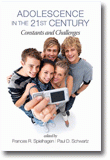
Adolescence in the 21st Century
Constants and Challenges
Edited by:
Frances R. Spielhagen, Mount Saint Mary College
Paul D. Schwartz, Mount Saint Mary College
Published 2013
What is wrong with young people today? This question has captured the concerns of the older generation about the habits and attitudes of the adolescents in their midst. The assumption is that there is indeed something wrong with young people. Even Plato must have rolled his eyes, as he relates his diatribe about the adolescents of Greece. Is the current generation of adolescents less motivated or less focused than their parents? How will they respond to the challenges facing them as they progress to adulthood? When, in fact, do they become adults? Although every generation draws upon their own unique and varied experiences, the speed of our current societal changes has created a very different adolescent passage for contemporary youth than ever before.
The world as we know it has changed significantly and because of it, much of today’s youth is decidedly different from their parents. Adolescence itself has shifted dramatically. Young children are displaying adolescent behaviors well before they are ready to act on or understand their meaning, and older adolescents are staying perpetual children. As one writer put it, “the conveyer belt that transported adolescents into adulthood has broken down”. This book provides an interdisciplinary collection of research on the constants and challenges faced by young people today. Failure to launch? Social media? Economic stagnation? For the generation that is coming of age in a post-terrorist world and in the midst of economic upheaval, the challenges might seem insurmountable. However, in this book, scholars from across the academy, from sociology, psychology, education, philosophy, science, and business, explain how the young people today are responding to the constants of growth and change in adolescence and the unique challenges of life in the 21st century.
CONTENTS
Foreword: Adolescence in the 21st Century, David Elkind. Preface, Frances R. Spielhagen, and Paul D. Schwartz. Part 1: Examining the Adolescent in the 21st Century, Frances R. Spielhagen, and Paul D. Schwartz. Seeking the Right Fit: From Training Bras to Self-Identity as Adolescents Search for Self, Susan Riemer Sacks. Talk to Me... Mothers’ Experience of Communicating with their Young Adolescent Daughters, Debra A. Hrelic. Parental Religiosity and Adolescent Educational Attainment: The Role of Non-Cognitive Skills, Gregory M. Eirich. Adolescent Literacy Development and the New Literacies: Challenges and Possibilities, J. David Gallagher. Socio-psychological problems among youth in Russia in the new millennium, Olga E. Lomakina and Tatiana I. Gustomyasova. Part 2: Constants: Purpose, Agency, and Motivation, Frances R. Spielhagen. Service-Learning as a Tool for Developing Emerging Adults into Productive Employees and Citizens, Moira Tolan. Doing Social Justice: The MYTI Program and Inner City Students, Rosaria Caporrimo and David Kerner. Adolescents with Autism Spectrum Disorder, Irene Van Riper. “Education of Peacemakers: Raising College Students’ Awareness of and Respect for the ‘Other’” Diane Bliss and Margaret Murphy. Part 3: Challenges: Emerging Adulthood, Paul D. Schwartz. The Challenge of Acceptance: Digitalk and Language as Conformity and Resistance, Kristen Hawley Turner. Homeless Adolescent Mothers: Engaging Strengths Emergent in Parenthood, Marina Mazur,
Alexandra Jordan, Aurelie Athan, Lisa Miller. Prenatal Cocaine Exposure- Two Decades Later: A Case study, Rae Fallon. My Body, My Biography: The use of narratives of self injury as a path to wholeness, Susan A. Conte. Music and Emotion Regulation among Emerging Adults, Janice C. Stapley.
-
Paperback9781623964962
Web price: $45.04 (Reg. 52.99)
-
Hardcover9781623964979
Web price: $80.74 (Reg. 94.99)
- eBook9781623964986

- FAM003000 - FAMILY & RELATIONSHIPS: LIFE STAGES: Adolescence
- EDU037000 - EDUCATION: Research
- EDU013000 - EDUCATION: Finance
-
 (Re)Envisioning Social Studies Education Research
Current Epistemological and Methodological Expansions, Deconstructions, and Creations
(Re)Envisioning Social Studies Education Research
Current Epistemological and Methodological Expansions, Deconstructions, and Creations
-
 American Educational History Journal - Golden Anniversary Edition
Volume 50 Numbers 1 & 2
American Educational History Journal - Golden Anniversary Edition
Volume 50 Numbers 1 & 2
-
 Distance Learning
Volume 20 #3
Distance Learning
Volume 20 #3
-
 Distance Learning
Volume 20 #4
Distance Learning
Volume 20 #4
-
 Faculty Development
Achieving Change Through Action Research
Faculty Development
Achieving Change Through Action Research
-
 Qualitative Research With Diverse and Underserved Communities
Qualitative Research With Diverse and Underserved Communities
-
 Quarterly Review of Distance Education
Volume 24 #1
Quarterly Review of Distance Education
Volume 24 #1

